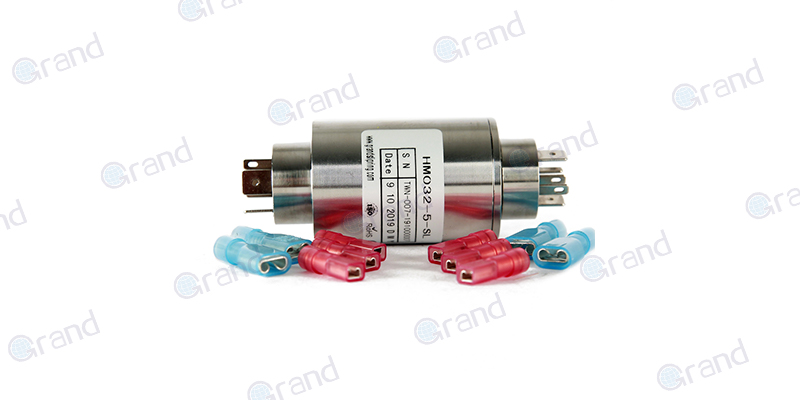Liquid metal slip rings, an innovation within mechanical and electrical engineering, act as a pivotal link in transferring electrical power and signals from a stationary component to a rotating one without breaking the circuit. They employ a unique technology where liquid metal serves as the key conductive medium, offering a seamless, constant electrical connection while the equipment part rotates. Its fundamental principle is that the liquid state is maintained, so rotation and physical wear, which cause degradation in traditional slip rings, have minimal impact on its performance.
In a world where industries are consistently pushing the limits of efficiency and reliability, the importance of liquid slip rings is magnified. These slip rings–part of an array of devices essential for electricity transmission between static and movable machine parts–package longevity, robustness under extreme conditions, and excellent conductivity in their construction. They are employed across numerous sectors, from wind energy generation where they efficiently handle high-power transmission, to the field of medical technology, specifically in imaging devices like MRI machines where they ensure consistent and low-noise signal transmission. Their usage also spans other industries like automation, aerospace, and military equipment that require flawless transmission of signals and power in extremely critical and challenging situations.
The integration of liquid metal slip rings brings remarkable technological breakthroughs in these sectors, enhancing equipment’s performance, durability, and operational life. In essence, these innovative components are reshaping the framework of electrical transmission solutions in rotating equipment, promising leapfrog advancements in a host of applications in sectors dependent on it. Whether it’s about propelling renewable energy technology to new heights or improving diagnostics in healthcare through high-performing scanners, liquid metal slip rings stand at the confluence of this revolution, redefining the future trajectory of these industries.
Why Liquid Metal Slip Rings
The conventional slip ring models, while effective, confront certain challenges such as frictional wear, electrical noise, and uneven signal transmission. Herein lies the uniqueness of liquid metal slip rings. They introduce a paradigm shift in slip ring technology thanks to their distinct construction and exceptional characteristics. Unlike traditional slip rings that rely on physical brushes and rings for transmission, liquid metal slip rings utilize liquid metal – often a gallium-indium alloy that remains liquid at room temperature – to complete the electrical circuit. This liquid metal forms the connective bridge for transmitting the power or signals from stationary to rotary components. By eradicating the reliance on brush contact, these slip rings negate problems related to friction, ensuring smooth, unhindered rotation and longer service life.
As for their benefits, the liquid metal slip rings are a trove. To start with, their innovative design using a liquid conductive medium facilitates consistent, unbroken, and low-resistance contact, unlike traditional slip rings that may suffer from intermittent contact due to wear and tear of brush and ring. Their design also reduces electrical noise, which could otherwise compromise the quality and integrity of signal transmissions. This feature is a boon, especially for industries like healthcare and telecommunications, where maintaining the precision and accuracy of signals is paramount.
Beyond this, the liquid metal slip rings exhibit outstanding performance under extreme conditions. Unlike conventional slip rings whose performance may degrade under high rotational speeds or extreme temperatures, liquid metal variants show remarkable robustness, maintaining their performance when subject to high-speed rotations or under wider temperature variations. Their composition and design lend them the ability to withstand the duress of demanding applications, truly setting them apart and confirming their worth across various sectors – from renewable energy and industrial automation to sophisticated medical and military equipment. Indeed, liquid metal slip rings are a testament to how modern technology can redefine standards, and push the boundaries of conventional systems.
Working Principle of Liquid Metal Slip Rings
A liquid metal slip ring operates on a fairly straightforward principle, but behind the apparent simplicity lies intricate engineering. Essentially, the design comprises a rotating part and a stationary part. The stationary part typically incorporates a tube filled with liquid metal. The rotating part hosts a rod or a shaft that extends into this liquid metal-filled tube. When the shaft rotates, the liquid metal inside the tube maintains a continuous and consistent electrical connection between the static and rotating components. This phenomenon ensures that the electrical current or signals flow without disruption even during full 360-degree rotations.
Though it might seem simple, achieving this smooth operation requires meticulous engineering. For instance, to prevent leakage and ensure even distribution of the liquid metal, superior sealing technologies are incorporated. Modern designs also include grooves or channels in the shaft insert to facilitate an even spread of the liquid metal, ensuring optimal contact and conductivity.
An intriguing question is: why liquid metal? Well, the answer lies in its superior electrical properties and physical stability. The commonly used liquid metal in these rings is a Gallium-Indium alloy. This alloy stays in a liquid state at room temperature and exhibits excellent electrical conductivity, akin to solid metals like copper or silver. Its liquid state allows it to form seamless contact with the rotating part, facilitating steady signal transmission, regardless of the speed of rotation. Moreover, unlike typical solid metal brushes in traditional slip rings, liquid metal doesn’t wear or degrade due to friction, ensuring extended durability and lesser maintenance.
Also, the liquid metal presents impressive thermal stability. It can operate efficiently over a wide temperature range, making it proficient for applications exposed to extreme temperatures. Together, these properties make liquid metal an attractive choice for use in slip rings, culminating in a device that’s not only efficient but also durable and reliable for a diverse range of applications.
Common Applications of Liquid Metal Slip Rings
Liquid metal slip rings have made their mark in various sectors, given their superior properties and the wide range of performance advantages they offer. Here’s a look at some of the sectors where these innovative components play a critical role.
Wind Energy Industry
Wind turbines rely heavily on slip rings for transmitting power and signals from the stationary mast to the rotating blades. However, traditional slip rings often struggle to manage the high-power transmission requirements and constant high-speed rotations typical in wind turbines. Enter liquid metal slip rings. With their low resistance, high-speed handling capacity, and minimal maintenance requirement, they significantly enhance the overall performance and reliability of wind turbines.

Medical Equipment
High-precision, low-noise, and reliable signal transmission are paramount for medical equipment, especially imaging machines like MRI (Magnetic Resonance Imaging). Liquid metal slip rings in such machines assure continuous, low-noise signal transmission, allowing for precise imaging and diagnostics.

Aerospace and Military Equipment
In sectors where the margin for error is minimal, the stability and reliability of liquid metal slip rings are extremely valued. From radar systems that require uninterrupted rotations for scanning to targeting systems in military equipment – the superior performance and reliability of liquid metal slip rings make them an essential component.

Heavy Machinery and Robotics
In industrial automation or robotics, the requirement for continuous power and signal transmission with no downtime is critical. Liquid metal slip rings meet this demand, especially where high rotary speeds and extreme conditions are involved.

To illustrate its real-world impact, let’s look at an example in the wind energy sector. In the past, wind turbines often faced inefficiencies and downtime due to the wear and tear of traditional slip rings, making maintenance a regular and expensive necessity. With the adoption of liquid metal slip rings, there have been cases of significant improvements in turbine efficiency and a substantial reduction in maintenance costs. These innovative slip rings have resulted in a better performing, more dependable wind energy sector that is better positioned to harness renewable energy, thereby making a positive ecological impact.
In summary, the capabilities of liquid metal slip rings have turned them into an integral component in multiple sectors. As different industries continue to grapple with the challenges posed by their demanding environments, liquid metal slip rings serve as a beacon of technological innovation and efficiency.
Users’Most Common Concerns of Liquid Metal Slip Rings
When transitioning to newer technologies such as liquid metal slip rings, potential users often have legitimate concerns regarding pricing, durability, safety, maintenance, and possible complications. Let’s delve into these concerns with an in-depth look at the realities involved.
- Pricing: While liquid metal slip rings may have a higher upfront cost than their traditional counterparts, the extended lifetimes, reduced maintenance needs, and better performance typically result in lower overall operational costs long term. Therefore, the investment in these slip rings is usually offset by future savings and improved operational efficiency.
- Durability: Liquid metal slip rings are structured for durability. Given that they are immune to the physical wear and tear typical of conventional slip rings, they often outlast their traditional counterparts. The absence of the need for brush contact significantly reduces physical degradation, ensuring the device’s long-term operational capacity.
- Safety of Liquid Metal: The metals used in these slip rings, typically Gallium-Indium alloys, are non-toxic and pose no health risks. While caution should be exercised to prevent unnecessary exposure (as with any metallic substance), with proper handling, these metals present no significant safety hazards.
- Maintenance Requirements and Costs: One of the primary advantages of liquid metal slip rings is their low maintenance requirements. Since there is no physical contact involved in the transmission process, wear and tear are minimal, significantly reducing the frequency of replacements or repairs. The associated savings on maintenance costs over the device’s lifetime can be substantial when compared to regular slip rings.
- Liquid Metal Lifespan and Leakage: Liquid metal slip rings are designed to prevent leakage of the liquid metal, making use of advanced sealing technologies. Consequently, liquid metal leakage issues are rarely reported. As for the lifespan, given the metal’s resistance to oxidation and its physical stability, a well-designed and maintained liquid metal slip ring can function efficiently over extended periods, often lasting the entire lifetime of the equipment with which they are utilized.
Thus, while user concerns are entirely valid, much of the worry surrounding liquid metal slip rings can be allayed by understanding how these devices function, their benefits over conventional slip rings, and the mechanisms in place to guarantee their safe and efficient operations.
Choosing the Right Liquid Metal Slip Ring
Pinpointing the right liquid metal slip ring for a specific setting involves balancing several considerations. Here are the key factors users should pay attention to:
- Load Capacity: The first consideration should be the load capacity. It’s crucial to assess the power or signal load that the slip ring will be expected to handle. More substantial loads will require slip rings with higher current capacities to ensure smooth operation.
- Maximum Speed: Different systems may operate at various rotational speeds. Thus, it’s essential to choose a liquid metal slip ring that can comfortably maintain its performance at your system’s maximum rotational speed without causing any transmission losses or distortions.
- Temperature Handling: The operational environment’s temperature can influence a slip ring’s performance. So, you need to check that the chosen slip ring can operate effectively within the temperature range specific to your operations.
- Electrical Specifications: Other electrical specifications like voltage, resistance, number of channels, and type of signals (digital or analog) to be transmitted are also vital considerations. Therefore, it’s necessary to match these specifications when choosing a liquid metal slip ring to prevent any compatibility issues.
When it comes to choosing a vendor or manufacturer, several standards should be met:
- Experience and Reputation: Opt for manufacturers with a good track record in producing high-quality liquid metal slip rings. You can verify this through customer reviews, case studies, or industry recommendations.
- Customer Support: Strong customer service is an important aspect. The vendor should be willing to answer queries, provide technical support, and react swiftly to any potential issues.
- Customization Options: Each application for a liquid metal slip ring can be different. Therefore, having a manufacturer who offers customization options based on specified design, material, or performance needs will be a distinct advantage.
- After-Sale Services: Look out for reliable after-sale services, including easy availability of replacement parts, accessibility of technical services, and clarity and length of warranty.
Remember, settling for the right vendor is as important as selecting the appropriate liquid slip ring. It’s a strategic decision that can impact operational efficiency, reliability, and the overall bottom line of your application or project.
Innovations in Liquid Metal Slip Ring Technology
The ever-evolving landscape of technology continues to bring advancements to the realm of liquid metal slip rings, constantly pushing the limits of efficiency, durability, and versatility.
- Efficiency Enhancements: Modern designs are aiming for even lower resistance and higher current carrying capacities. A more considerable focus is being placed on having custom solutions for varying load requirements. By tailoring the design and liquid metal composition for specific applications, manufacturers are achieving highly efficient and optimized liquid metal slip rings.
- Durability Improvements: Recent advancements have further enhanced the durability of liquid metal slip rings. Innovations focus on improving sealing mechanisms to prevent any potential liquid metal leakage over extended operational periods. These improvements have also been accompanied by advancements in materials used for the housing, aiming for long-lasting service in even the harshest of environments.
- Miniaturization: One exciting realm of development has been the miniaturization of liquid metal slip rings, catering to smaller, more compact applications without compromising on performance or durability.
Looking at future trends, these developments only scratch the surface of what could become possible.
- Integration with IoT and AI: As we move further into the age of IoT and artificial intelligence, we can see liquid metal slip rings playing a pivotal part. Seamless integration of slip ring technology with IoT-enabled devices could allow for real-time monitoring, predictive maintenance, and intelligent control—further improving performance and longevity.
- Sustainable Solutions: As industries across the board look towards sustainable and eco-friendly solutions, liquid metal slip rings’ development will likely follow suit. Efforts to reduce power usage, increase efficiency, and find recyclable or environmentally friendly component alternatives will likely be a significant focus.
- Customized and Application-Specific Rings: A movement towards more tailored solutions seems imminent. Predetermined categories may give way to application-specific slip rings, built according to individual project or application requirements, delivering enhanced performance in specific operating conditions.
The future, thus, is undoubtedly exciting. These advancements and those still to come will continue pushing the envelope of what liquid metal slip rings can achieve, fostering even better operational capabilities, reliability, and sustainability.
Conclusion
In conclusion, liquid metal slip rings bring to the table a plethora of benefits that escalate equipment performance and longevity. Though users may have certain concerns, the advancements in the technology seem all poised to address these effectively, making such slip rings an advantageous consideration for a broad spectrum of applications. It won’t be an exaggeration to state that liquid metal slip rings are transforming the landscape of rotational power and signal transmissions.
See What We Can Do

